Bulletin – June 2010 The Impact of the Financial Crisis on the Bond Market
- Download the article 238KB
Abstract
The Australian bond market functioned well during the financial crisis. Changes in investor sentiment and issuer behaviour led to a slowing in issuance and an increase in the average credit quality of new issuance. While the average bond term shortened and spreads widened, these trends have since reversed somewhat as market conditions have improved.
Introduction
The bond market is a key funding tool for many Australian financial institutions and corporates. A wide range of issuers and investors participate in the market. The Australian non-government bond market can be divided into four main categories:
- bonds issued by Australian financial institutions;
- bonds issued by Australian corporates (non-financials);
- long-dated asset-backed securities (ABS) issued by Australian-domiciled vehicles; and
- Australian dollar bonds issued in Australia by non-residents, known as Kangaroo bonds.
Over the decade to 2007, the stock of non-government bonds outstanding increased from $110 billion to over $750 billion, to be over six times larger than the government bond market. The non-government bond market has continued to expand over recent years, but the growth rate slowed during the financial crisis as investor risk aversion increased and the demand for debt financing declined.
There was a clear turning point for the bond market in mid 2007 when the early stages of financial turmoil emerged in money markets. Because of this, mid 2007 is used in this article as the starting point for the financial crisis so far as it pertains to the bond market. Unlike the global experience, there were few rating downgrades and negligible bond defaults in the Australian market during the financial crisis. Credit quality of the market remained high. There were, however, substantial changes in the sectoral composition of the market. The reduction in investor appetite for credit risk during the crisis saw bond terms at issuance shorten, bond spreads widen to historical highs and an increase in the average credit quality of new issues, particularly after the introduction of the Government's Guarantee Scheme for Large Deposits and Wholesale Funding. Bond terms have subsequently lengthened as market conditions settled. While spreads also narrowed significantly, they are not expected to return to the levels seen prior to the financial crisis in the near future.
Issuance Patterns
Over the decade prior to the onset of the financial crisis, the Australian bond market grew significantly. Unsecured bond issuance by financial institutions was strong, particularly offshore, and an increasing range of corporates accessed capital market funding. Kangaroo bond issuance also increased, contributing to the depth and diversity of the domestic market.[1] Growth in ABS, most of which was residential mortgage-backed securities (RMBS), was particularly strong. The rapid growth in securitisation reflected a number of factors including:
- strong demand for housing finance;
- increased competition from mortgage originators, which typically relied on securitisation for funding;
- the desire by banks to diversify their funding; and
- investor demand for high-yielding AAA-rated securities, making this a cost-effective way of raising funds for many borrowers.
By mid 2007, ABS had grown to be close to 30 per cent of the stock of bonds outstanding, financials were 40 per cent, corporates were 18 per cent and Kangaroos 13 per cent.
The onset of the financial crisis in the bond market in mid 2007 led to a reversal of some of these issuance patterns (Graph 1). As has been well documented elsewhere, the collapse of the US sub-prime mortgage market led to a general reappraisal of the risks involved with all structured credit markets and a widespread increase in risk aversion.[2] While these events had an impact on the entire Australian bond market, the securitisation market was most affected. Although the Australian securitisation market was not subject to the shortcomings of the US market, investor appetite dried up.[3]
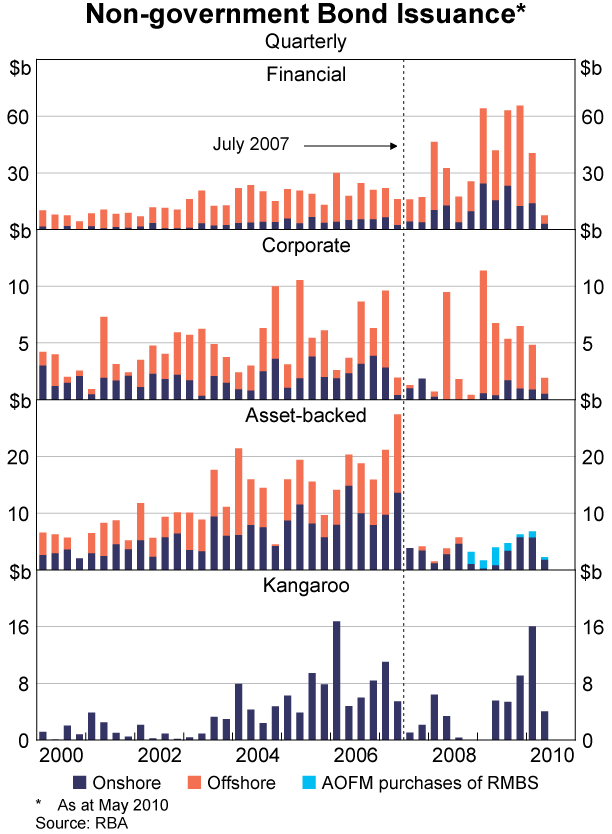
In addition to the reduction in investor demand, sales of existing RMBS by distressed leveraged foreign investors contributed to the dislocation in the securitisation market; these investors were mainly structured investment vehicles (SIVs) which owned around one-third of Australian RMBS prior to the financial crisis. This overhang of supply saw RMBS spreads increase significantly to the point where issuance was not economic for most lenders and access to the market was limited. Since mid 2007, quarterly issuance of RMBS has averaged $3 billion compared with average quarterly issuance of $15 billion in the two years pre-crisis. And, in contrast to the years preceding the financial crisis – during which RMBS issuance was evenly split onshore and offshore – issuance has been entirely into the domestic market, with the Australian Office of Financial Management (AOFM) being a major investor in some issues. (Around one-quarter of the RMBS issued since the start of the crisis has been purchased by the AOFM.)
The global rise in risk and risk aversion also saw the cost of lower-rated corporate bond issuance increase sharply and, for a period, some corporates had difficulty accessing the bond market. One result of this was that many corporates turned to the banks for funding. The stock of corporate bonds outstanding fell for a short time, but as bond spreads narrowed over 2009, corporates began to tap the bond market again, substituting this for borrowings from banks. Corporates also sought to reduce their leverage by raising equity to pay down bank debt.[4] While bond issuance was initially limited to larger corporates with an established presence in offshore capital markets, the range of borrowers broadened as investor demand for credit started to pick up in 2009, with a number of medium-sized entities also issuing bonds.
The dislocation of the securitisation market and, in the initial stage of the financial crisis, the reintermediation of the corporate sector, saw banks' balance sheets grow as they gained market share. In contrast, mortgage originators, who relied on RMBS for funding, sharply scaled back their lending to households – the share of housing loans funded by securitisation fell from almost 25 per cent in mid 2007 to around 10 per cent in early 2010. While the banks also ceased using securitisation as a form of funding, they retained good access to the bond market and issued large volumes, supported by their strong balance sheets and, at the peak of the financial crisis, the introduction of the Government's Guarantee Scheme.[5] The share of banks' funding sourced from the bond market rose by a few percentage points to almost one-quarter of funds as they sought to use more stable sources of funding.
Kangaroo bond issuance was relatively subdued during much of the crisis period with quarterly issuance averaging less than $2 billion until early 2009 compared with $7½ billion in earlier years. There were no issues between August 2008 and April 2009. Issuance returned in the second half of 2009, followed by near-record issuance in the March quarter of 2010, underpinned by strong investor demand and a very favourable cross-currency basis swap spread (which is received by Kangaroo issuers as they swap out of Australian dollars and into another currency).
In total, bond issuance slowed during the crisis. The average annual growth rate in the stock of Australian bonds outstanding slowed to 7 per cent from the rapid pace of over 20 per cent over the previous decade, though trends differed significantly across sectors. Notably, the limited RMBS issuance, along with the ongoing amortisation of principal (i.e. mortgage repayments), led to the stock of RMBS outstanding halving between mid 2007 and May 2010 (Graph 2). In contrast, the stock of financials' bonds outstanding increased sharply, with the average annual growth rate picking up to 21 per cent from 18 per cent. The stock of corporate bonds outstanding has grown modestly over this period, while the stock of Kangaroo bonds outstanding also increased a little.
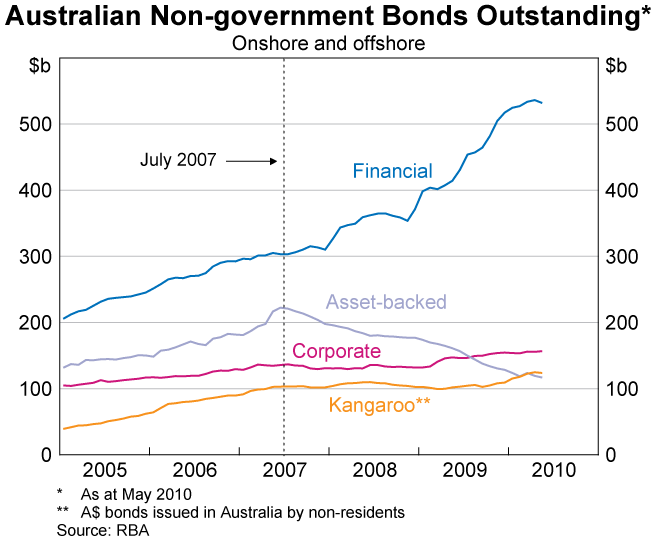
Reflecting these developments, the composition of the bond market has changed significantly (Table 1). The share of bonds outstanding comprised of ABS has fallen 16 percentage points to 13 per cent, offset by an increase in financials' share (up 17 percentage points to 57 per cent). Shares of corporate and Kangaroo bonds have both remained broadly unchanged, at 17 and 13 per cent, respectively.
| Outstanding $ billion | Share Per cent | Average annual growth Per cent | ||||
|---|---|---|---|---|---|---|
| Jun 2007 |
May 2010 |
Jun 2007 |
May 2010 |
Jun 1997– Jun 2007 |
Jul 2007– May 2010 |
|
| Financials | 304 | 532 | 40 | 57 | 18 | 21 |
| Asset-backed | 222 | 117 | 29 | 13 | 30 | −20 |
| of which | ||||||
| RMBS | 176 | 95 | 23 | 10 | 33 | −19 |
| Corporates | 136 | 157 | 18 | 17 | 14 | 5 |
| Kangaroo(a) | 103 | 124 | 13 | 13 | 41 | 6 |
| Total | 765 | 929 | 100 | 100 | 21 | 7 |
|
(a) A$ bonds issued domestically by non-residents Source: RBA |
||||||
Spreads
In the lead-up to the financial crisis, Australian bond spreads narrowed, consistent with global trends. This reversed sharply during the financial crisis as risk aversion increased, with spreads widening to historical highs.
As noted earlier, securitisation markets globally were significantly affected by investors' reassessment of risk, and accordingly, spreads on ABS increased by more than on other assets. Secondary market spreads on Australian RMBS also increased significantly – as distressed leveraged foreign investors liquidated their positions – to be well above the break-even spread at which it was economic to issue RMBS (Graph 3).
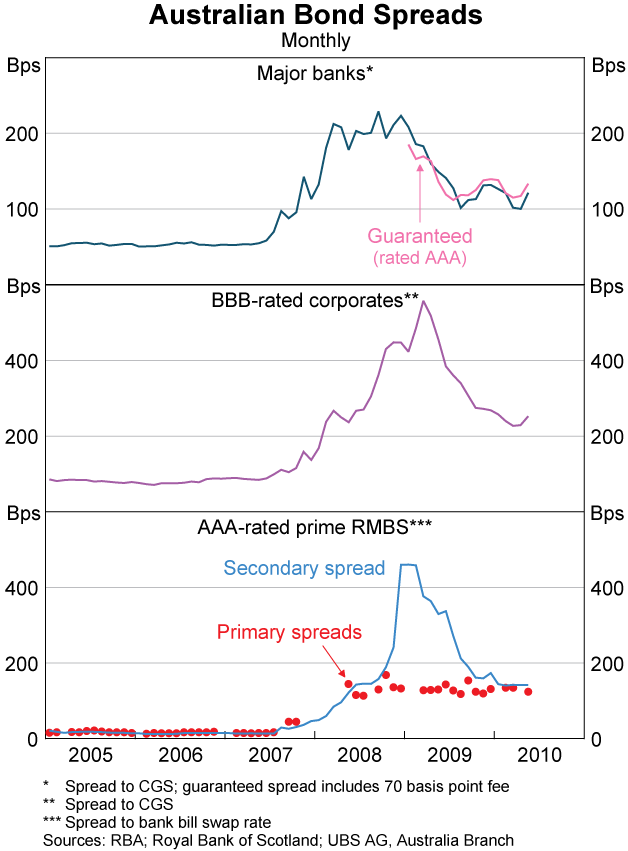
Spreads on bank and corporate bonds also rose sharply. For example, secondary market domestic spreads to Commonwealth Government securities (CGS) on 3-year major banks' unguaranteed bonds increased by around 170 basis points to peak at 225 basis points at the height of the financial crisis. Spreads on BBB-rated corporate bonds continued rising for a few more months, peaking at 560 basis points in March 2009.
As market conditions settled and investor risk aversion started to ease in 2009, spreads narrowed across all bond classes. Primary and secondary market spreads on RMBS have broadly converged, suggesting that the market has worked through most of the overhang of supply associated with sales by SIVs. Although spreads on issues in the primary market remain high by historical standards, recent issues, including those without the AOFM as a cornerstone investor, have been marginally profitable for the issuers.
Spreads on the banks' unguaranteed bonds narrowed over 2009 as investors' appetite for credit returned, with spreads now around the same level as in late 2007. While corporate bond spreads have narrowed, they are yet to return to their late 2007 levels.
Spreads across the spectrum of bonds have narrowed significantly since the height of the dislocation in markets, but they remain above the unusually low levels observed prior to the financial crisis.
Bond Maturity
Prior to the financial crisis, the most common maturity of Australian unsecured bonds at issuance was between four and six years, with an average maturity of close to six years.[6] With the increase in risk aversion during the financial crisis, investors were more reluctant to commit their funds for long periods given the uncertain environment. As a result, the distribution of bond terms shifted toward shorter maturities, with nearly 30 per cent of bonds issued between July 2007 and end 2008 at maturities of one to two years compared with 8 per cent previously (Graph 4). The shortening of bond terms was driven by trends in banks' bond issuance, which made up the bulk of bond issuance over the period, though this trend was also consistent across the corporate and Kangaroo sectors. More recently, the distribution of bond terms has lengthened as investor risk aversion has eased and banks have increasingly issued bonds at longer terms. Since 2009, only around 10 per cent of bonds were issued at terms of one to two years and around 55 per cent has been at terms of four years or more, up from 40 per cent at the height of the financial crisis.
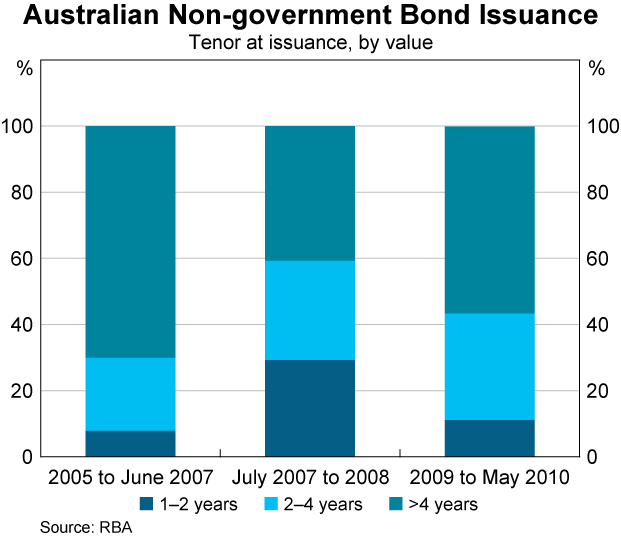
In contrast to unsecured bonds, the average outstanding term of Australian RMBS lengthened a little during the crisis, with some RMBS remaining outstanding longer than initially expected by investors. This was consistent with the global experience. Unlike most other bonds, RMBS do not have a ‘bullet’ maturity; rather than having a fixed maturity, they are repaid as the underlying mortgages are repaid, on average in around three to four years. RMBS are typically structured with an option for the issuer to redeem the RMBS before all of the underlying mortgages are repaid. This option – known as a ‘clean-up call’ – enables RMBS to be redeemed before the income from a declining pool of mortgages falls below the administrative costs of managing the RMBS, which protects investors from being left with a small, illiquid stock of bonds. Historically, RMBS were called at the first available opportunity – with the small value of mortgages still outstanding repackaged into new RMBS – and were priced by investors based on this assumption. However, during the financial crisis, some issuers did not exercise their first available clean-up call. In part this reflected a change to prudential standards in January 2008, whereby Australian authorised deposit-taking institutions were no longer permitted to call their RMBS when more than 10 per cent of the pool of mortgages remained outstanding.
Bond Covenants
Covenants are contractual restrictions designed to align borrowers' actions with lenders' interests. In the years leading up to the financial crisis, weaker covenants were included in some new bonds (and some bank loans). In contrast, following the increase in risk aversion associated with the financial crisis, investors have demanded stronger covenants. Recently issued corporate bonds have contained covenants such as negative pledges (to prevent the issuer from issuing debt that would rank higher than the bond) and change of control provisions (the investor has a ‘put option’ to sell the bond back to the issuer if there is a change of control at the company that could reduce credit quality, such as a leveraged buy-out).
Credit Quality
Australia's non-government bond market has historically been of high credit quality. Between 2000 and mid 2007, over 40 per cent of issuance was rated AAA, with a further 36 per cent rated AA and the remainder almost entirely investment grade (at least BBB–, Graph 5).[7] The high average credit quality reflected strong issuance of RMBS (most of which are rated AAA) and by the highly rated major banks (which account for the bulk of financials' bond issuance and are rated AA), as well as corporates using credit wrapping (private guarantees) to boost their ratings to AAA.[8]

Since mid 2007, issuance has continued to be concentrated among highly rated entities and, in fact, the distribution of issuance has shifted even more towards the highest-rated entities. This reflects increased investor preference for low-risk financial assets, particularly AAA-rated securities (with the exception of structured credit products). The high credit quality has also been underpinned by the sound balance sheets of Australian financial institutions and the corporate sector, the resilience of the domestic economy, and the introduction of the Government guarantee on wholesale funding. The average share of issuance since mid 2007 that was AAA-rated is 50 per cent, 7 percentage points higher than prior to the crisis, and the share rated AA has also increased a little. This largely owed to strong guaranteed and unguaranteed issuance by the major banks more than offsetting the lack of RMBS issuance.
Consistent with trends in issuance, the credit quality of the stock of Australian bonds outstanding increased in recent years (Graph 6). This largely reflected changes in issuance patterns as there have been limited rating changes for Australian bonds. This is in contrast to the international experience of relatively widespread downgrades. Australian bond issuers continue to be highly rated compared with the global average, with 85 per cent of Australian issuers rated investment grade compared with 60 per cent of global issuers.[9]
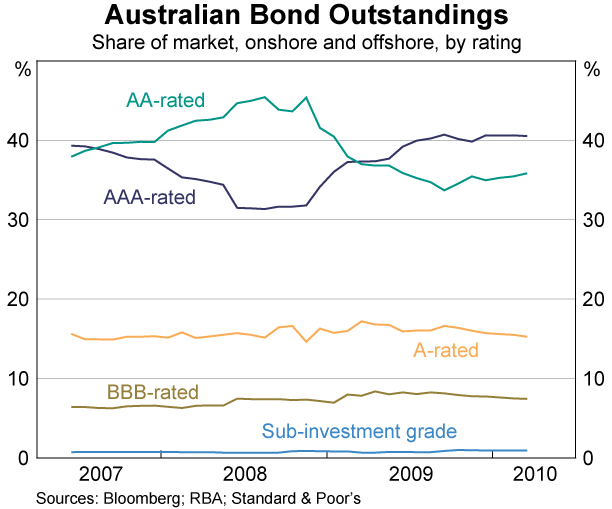
Whereas globally there were significant downgrades to structured credit instruments, the credit quality of Australian ABS outstanding has remained very high, with almost all AAA-rated RMBS tranches having retained their rating. This reflects the quality of loans securitised, which have been underpinned by the strength of the domestic economy. While there have been negligible rating downgrades, the ongoing amortisation of principal, combined with limited issuance, has nonetheless caused the outstanding value of AAA-rated RMBS to fall sharply.
Also in contrast to their global counterparts, there were only limited downgrades to the credit ratings of the Australian-owned banks during the financial crisis – the major banks all retained their AA rating and continue to be among the most highly rated banks globally.[10] In the initial stages of the financial crisis, strong bond issuance by the major banks pushed up the stock outstanding of AA-rated bonds. Then as the crisis intensified, the Australian banks issued a large volume of Government-guaranteed AAA-rated bonds in response to an increase in investor risk aversion globally. As market conditions settled over 2009 and investor appetite for credit risk increased, the banks reduced their use of the guarantee and issued an increasing volume of unguaranteed (AA-rated) bonds. AAA-rated guaranteed bonds currently make up about one-third of the stock of financial bonds outstanding.
Almost all Australian corporate bonds are investment grade and most maintained their rating during the financial crisis. Credit-wrapped bonds, which account for around 10 per cent of corporate bonds, were an exception to this. Credit wrapping is a type of credit enhancement whereby a bond insurer guarantees to meet interest and principal payments as they fall due if the issuer defaults. At issuance, almost all credit-wrapped bonds had a AAA rating by virtue of the bond insurers' ratings. However, many bond insurers have suffered multiple downgrades since the beginning of 2008 and most now have ratings lower than the underlying ratings of the issuers, with several rated below investment grade. While 80 per cent of these credit-wrapped bonds have been downgraded, they are still all rated investment grade, reflecting the solid stand-alone ratings of Australian corporates – $5 billion are still rated AAA, $5 billion have been downgraded to A and $15 billion have been downgraded to BBB.
Whereas prior to the crisis, Kangaroo issuance was split evenly between AAA and AA-rated bonds, issuance has been almost entirely by AAA-rated entities since mid 2007. This partly reflects investors' greater risk aversion towards lower-rated securities and appetite for highly rated bonds. The resultant pick-up in credit quality has been partly offset by credit rating downgrades to the outstanding bonds of some foreign financial institutions during the crisis.
Defaults
The resilience of the Australian bond market throughout the financial crisis is also evident in the limited default experience, compared with the significant spike in defaults in global bond markets. No publicly rated financial or corporate bond issued by an Australian entity has defaulted during the financial crisis; the most recent publicly rated bond default by an Australian entity was 2003. In comparison – and reflective of the global bond market – the first bond defaults by Kangaroo issuers occurred in 2008 (Lehman Brothers and two Icelandic banks). Nonetheless, these make up only a small share of the Kangaroo market, accounting for around 1 per cent of the stock outstanding (and 0.1 per cent of the Australian bond market).
Unlike international RMBS, no losses have been borne by an investor in a rated tranche of an Australian RMBS. There have been a few small value defaults of other ABS, though in total these make up just 0.2 per cent of the Australian ABS market.
Conclusion
The Australian bond market was resilient during the financial crisis. Credit quality remained high and in contrast to the global experience, there have been only limited rating downgrades or defaults in the Australian market in recent years. The decrease in investor appetite for risk and changes in issuer behaviour did, however, result in slower overall issuance, an increase in the quality of new issuance, shorter bond terms, tighter bond covenants and spreads reaching historical highs. As market conditions have improved, bond terms have lengthened, and spreads have narrowed, although spreads are higher than the unusually low levels observed in the lead-up to the financial crisis.
Footnotes
The authors are from Domestic Markets Department. [*]
For a discussion of the factors that have contributed to the strong growth in Kangaroo bonds see Ryan (2007). [1]
For example, RBA (2007a, 2007b). [2]
See Debelle (2008) for a comparison of the Australian and US securitisation markets. [3]
For more information see Black, Kirkwood and Shah Idil (2009). [4]
For more information on the Guarantee Scheme see Schwartz (2010). [5]
Bonds are classified as securities with a maturity of at least one year. [6]
The limited sub-investment grade issuance by Australian issuers has been almost entirely into offshore markets (mostly the US market). While the lack of a sub-investment grade market in Australia contributes to the high credit quality of the domestic market, it means that lower-rated companies rely on bank loans or offshore capital markets for debt funding. [7]
For more information on credit wrapping see RBA (2008). [8]
Of entities rated globally by S&P, 18 per cent were downgraded in 2009; in contrast, 4 per cent of rated Australian entities were downgraded. [9]
While the outstanding bonds of some foreign subsidiaries operating in Australia were downgraded due to downgrades of their parents, this effect on the credit quality of financials' bonds outstanding was more than offset by the increased issuance of major banks' guaranteed and unguaranteed bonds. [10]
References
Black S, A Brassil and M Hack (2010), ‘Recent Trends in Australian Banks' Bond Issuance’, RBA Bulletin, March, pp 27–34.
Black S, J Kirkwood and S Shah Idil (2009), ‘Australian Corporates' Sources and Uses of Funds’, RBA Bulletin, October, pp 1–12.
Debelle G (2008), ’A Comparison of the US and Australian Housing Markets’, Address to the Sub-Prime Mortgage Meltdown Symposium, Adelaide, 16 May.
RBA (Reserve Bank of Australia) (2007a), Financial Stability Review, September.
RBA (2007b), Statement on Monetary Policy, November.
RBA (2008), ‘Box B: The Domestic Credit-Wrapped Bond Market’, Statement on Monetary Policy, August, pp 50–51.
Ryan C (2007), ‘Some General Observations on the Kangaroo Bond Market’, RBA Bulletin, April, pp 10–17.
Schwartz C (2010), ‘The Australian Government Guarantee Scheme’, RBA Bulletin, March, pp 19–26.